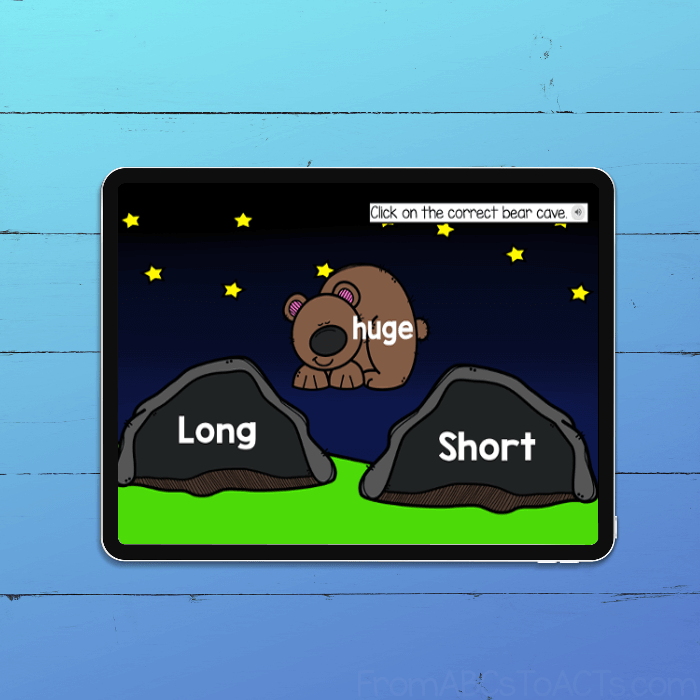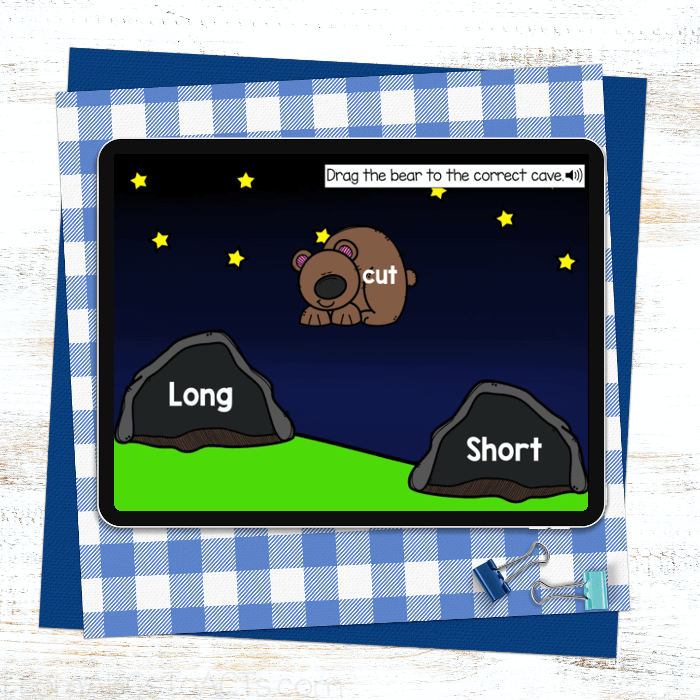This post may contain affiliate links. For more information, please see my full disclosure policy.
If there is one thing that pretty much all children love to learn about, it’s animals.
Animals of all shapes and sizes.
So, why not incorporate them into your learning to help keep your students engaged and entertained?
With this bear cave long and short vowel sound digital activity, you can do just that!

Making Language Arts Fun
Children absolutely love animals.
No secret there.
Whether you’re talking about the animals of the ocean, taking your toddler or preschooler to the zoo, or even listening to your children beg for a pet, the fascination with all creatures big and small is easy to spot.
Another pretty easy thing to spot?
The fact that those children don’t often extend that fascination to their language arts lessons.
I know, I know… Once again, no secret there.
They just don’t have the same excitement for vowel sounds that they do for animals.
But what if you could change that?
What if you could find a way to combine those two things, animals and vowel sounds, and get them excited about it?
Well, at the risk of sounding a bit like an infomercial, you can!
We did!

When thinking about the activities and resources that we wanted to incorporate into our learning this year, we put together a winter-themed activity that combines a child’s love of animals with long and short vowel sound practice and we made the whole thing digital.
Teaching Long and Short Vowel Sounds
Now, for some kids, vowel sounds can be kind of tricky.
They’ve typically learned, up to that point, that each letter makes a single sound.
Suddenly, with vowels, there are multiple sounds and it can be difficult for them to determine which sound belongs where.
Seeing them on paper doesn’t help much either because the same letters are simply used to make different sounds.
But when you combine seeing the word and simple repetition, you start getting somewhere.
Now, I don’t mean show them the same word a hundred times and expect it to stick, but rather the repetition of a pattern.
Start with Short Vowels
Short vowel sounds are typically much easier for children to remember as they are often used in some fairly predictable patterns.
Word families, for instance, are a fantastic way to start introducing short vowel sounds (it helps to introduce those word families one at a time) as children will have the ability to practice that same short vowel sound repeatedly without just repeating the same word over and over again.
Then Add the Long Sounds
It is only once they have mastered the short vowel sounds (through the use of practice tools like word families) that we move on to adding those long vowel sounds into the mix.
This is where we’ll take those CVC words that we used to practice those short vowel sounds and turn them into CVCe words for long vowel practice.
It can take some time for your students to master long and short vowels because they are more of an abstract concept and especially with long vowels as there are fewer concrete rules and multiple patterns that work to make the same sound.
But, as with all things, practice is key.
Practice and finding ways to make that practice fun.
Bear Cave Long and Short Vowel Practice

While the addition of a screen is not necessarily my favorite, computers and tablets can be very effective teaching tools, and in this particular case, make your vowel sound practice a whole lot of fun!
This digital bear cave long and short vowel sound activity will give your students the opportunity to practice long and short vowel sounds with 20 different words.
- robe
- beet
- cube
- cut
- cap
- fat
- cane
- hen
- hope
- kite
- pet
- pin
- pop
- made
- huge
- rag
- rob
- sit
- tree
- bite
Available on all three big digital platforms – Boom Learning, Google Slides, and Seesaw – this digital activity also gives your students the chance to help some sleepy bears as they look for a place to hibernate.
On all three platforms, your students will see a sleeping bear with a word printed on him and two separate caves.
These caves are labeled long and short.
On the Google Slides version, your students will read the word, decide whether it has a long or a short vowel sound, and then click on the correct bear cave.
On Boom Learning and Seesaw, however, they will drag the sleeping bear to the correct cave instead.
Both the Google Slides and the Boom cards version will provide them with instant feedback on their answers and give them the opportunity to try again if they got it wrong the first, but with all three available, you get to pick and choose the one that works best for you and your students!
